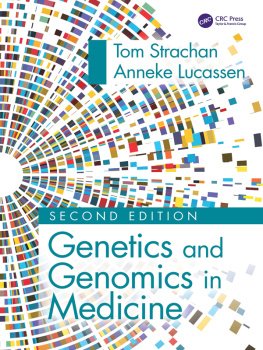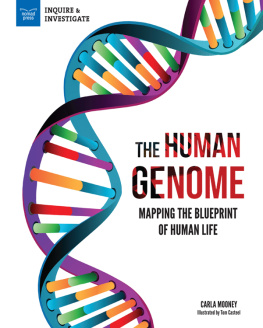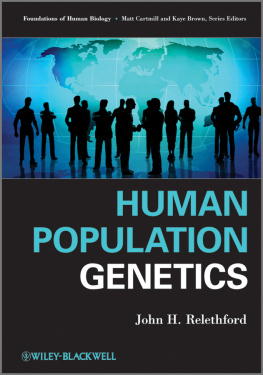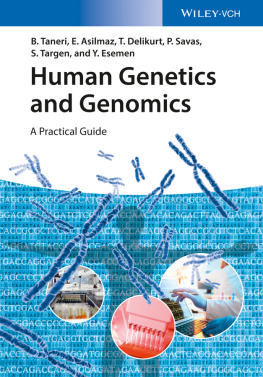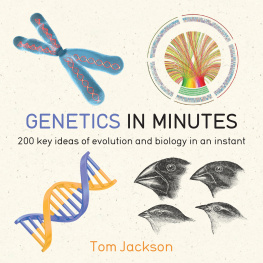Investigating the Human Genome
Insights into Human Variation and Disease Susceptibility
Moyra Smith
Vice President, Publisher: Tim Moore
Associate Publisher and Director of Marketing: Amy Neidlinger
Acquisitions Editor: Kirk Jensen
Editorial Assistant: Pamela Boland
Operations Manager: Gina Kanouse
Senior Marketing Manager: Julie Phifer
Publicity Manager: Laura Czaja
Assistant Marketing Manager: Megan Colvin
Cover Designer: Chuti Prasertsith
Managing Editor: Kristy Hart
Senior Project Editor: Lori Lyons
Copy Editor: Hansing Editorial Services
Proofreader: Kathy Ruiz
Senior Indexer: Cheryl Lenser
Compositor: Nonie Ratcliff
Manufacturing Buyer: Dan Uhrig
2011 by Pearson Education, Inc.
Publishing as FT Press
Upper Saddle River, New Jersey 07458
FT Press offers excellent discounts on this book when ordered in quantity for bulk purchases or special sales. For more information, please contact U.S. Corporate and Government Sales, 1-800-382-3419, .
Company and product names mentioned herein are the trademarks or registered trademarks of their respective owners.
All rights reserved. No part of this book may be reproduced, in any form or by any means, without permission in writing from the publisher.
Printed in the United States of America
First Printing June 2011
ISBN-10: 0-13216814-6?
ISBN-13: 978-0-13216814-4
Pearson Education LTD.
Pearson Education Australia PTY, Limited.
Pearson Education Singapore, Pte. Ltd.
Pearson Education Asia, Ltd.
Pearson Education Canada, Ltd.
Pearson Educacin de Mexico, S.A. de C.V.
Pearson EducationJapan
Pearson Education Malaysia, Pte. Ltd.
Library of Congress Cataloging-in-Publication Data
Smith, Moyra.
Investigating the human genome : insights into human variation and disease
susceptibility / Moyra Smith.
p. ; cm.
Includes bibliographical references.
ISBN-13: 978-0-13-216814-4 (hardback : alk. paper)
ISBN-10: 0-13-216814-6 (hardback : alk. paper)
1. Human genome. 2. Disease susceptibility. I. Title.
[DNLM: 1. Genome, Human. 2. Genetic Predisposition to Disease. QU 470]
QH447.S625 2011
611.01816dc22
2011006494
Dedication
This work is dedicated to the memory of three remarkable people who inspired and encouraged me long ago:
My mother Florence Van Eyk Smith, my grandfather Manard James Van Eyk, and our beloved family physician, Dr. Colin Roy Cockcroft.
Acknowledgments
I express my gratitude to researchers and clinicians who have worked hard and long to further our knowledge of genetics and genetic diseases. Preparation of this book would not have been possible without the amazing resources of the University of California library services and the online resources of the National Library of MedicineI want to acknowledge all who contribute to making these resources available.
I want to acknowledge Kirk Jensen, who encouraged me to write this book. I thank Lori Lyons of Pearson for moving this manuscript along in the publishing process and copy editor Krista Hansing for her thorough input.
Preface
In 2009, Georgina Ferry wrote, The optimism of science is twofold: that its methods might reveal, one tiny pixel at a time, more of the wonder of the natural world and that this knowledge might be able to solve practical human problems.
Progress in the fields of genetics and genomics since a draft sequence of the human genome was published in 2001 is indeed a cause for optimism. However, this discovery has left some people disappointed because development of new therapies to treat disease has been slower than anticipated. Availability of this sequence information has fueled groundbreaking studies in genetics, genomics, and epigenetics that provide insight into human variation and the pathogenesis of both common and rare diseases. The goal of this book is to briefly review several of those groundbreaking studies and new insights.
My own experiences during a 40-year career as a clinical geneticist and researcher in genetics and genomics influenced the choice of topics discussed in this book. I explore new insights into human origins, migrations, and human population diversity gained though genomic analyses. I consider insights into the etiology of common diseases such as diabetes and coronary heart disease. I also consider studies on synapses and synaptic plasticity, representing pathways to understanding mind and cognition.
I discuss complexities of late-onset neurological diseases and efforts to utilize genetic and genomic methodologies to unravel the pathogenesis of these disorders. I also consider new insights into aspects of protein misfolding and clearance or deposition as aggregates that sequester other proteins. In considering gene environment interactions, I focus on aspects of DNA damage and repair and DNA instability. An appropriate movement is underway toward translational research and greater emphasize on treatment. I review examples of treating primary defects and downstream effects of genetic disorders. I review new information on regulating gene expression at the levels of transcription, translation, and post-translational modifications. Growing evidence indicates that modifications of DNA, histones, and of nonhistone proteins greatly impact gene expression and the function of gene products, and I review aspects of research in these areas, sometimes referred to as epigenetics. In a chapter related to cancer, I review new discoveries in genetics and genomics that have direct relevance to therapy.
Growing evidence points to the importance of protein interactions and webs of molecular interactions that determine regulation and growth and the operation of systems, and I consider these topics. In a closing chapter I consider the relevance of genomics and systems biology to personalized medicine.
1. Genome architecture and sequence variation in health and disease
Availability of information on DNA sequence in human genomes and advances in technologies to amplify and sequence DNA have led to significant progress in delineating sequence differences that lead to disease. These techniques have also led to the discovery of sequence variants that occur in healthy individuals.
Studies of variation in the human genome are greatly facilitated through the availability of microarrays designed to detect single nucleotide polymorphisms (SNPs) that occur with frequencies greater than 1% to 5% in the population. Gene loci that are close to each other are often coinherited. SNP analyses can determine a series of alleles of loci in a specific region (a haplotype). Microarray technologies enable analysis of as many as one million SNPs on each array. These microarrays can also determine structural variation and copy number changes, defined as deletion or duplications greater than 1 kilobase (kb). Specific probes for regions known to frequently harbor copy number changes are also present on SNP microarrays such as the Affymetrix 6.0 array. Advances in technologies in DNA sequencing include massively parallel sequencing, often referred to as next-generation sequencing.
This chapter explores aspects of structural genomic variation and sequence variation in different populations and the role of sequence differences in the etiology of common disorders such as diabetes mellitus, obesity, and coronary heart disease. It also covers next-generation sequencing and examples of its application to the discovery of gene defects that lead to disease.
Through the use of polymerase chain reaction techniques, samples with low concentrations of DNA can be used to derive material for DNA sequencing. This chapter discusses applications of these techniques to discover how the sequence in modern humans differs from that of Neanderthals and early modern humans. Also presented are reports of studies of DNA extracted from two teeth from a man who died in 1783. DNA analysis enabled researchers to diagnose the disease that afflicted him and analyze the specific mutation and surrounding polymorphisms that connected him to present-day patients with the same disease.


